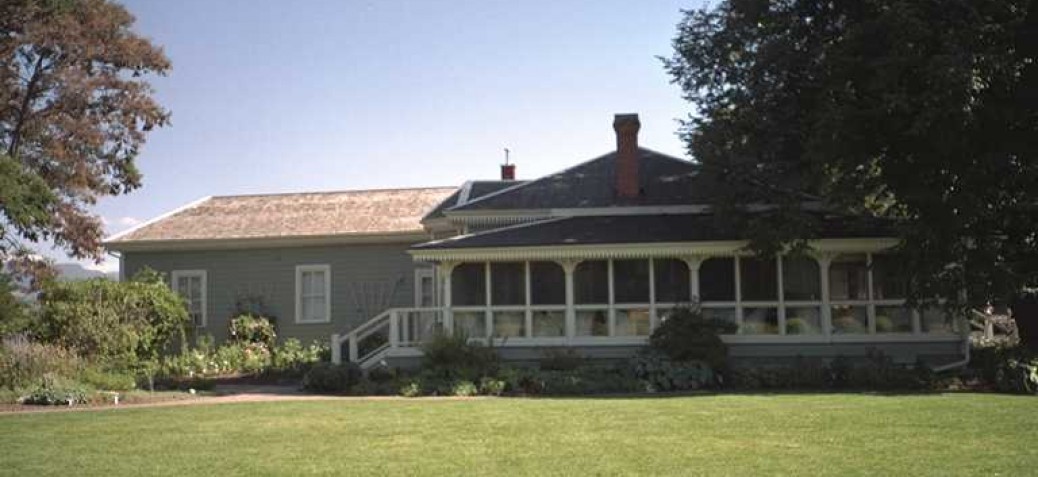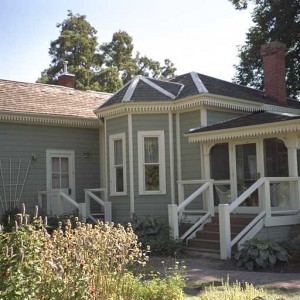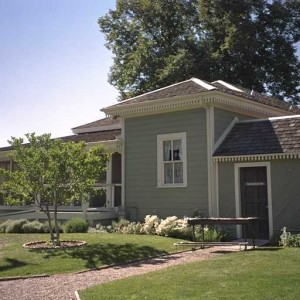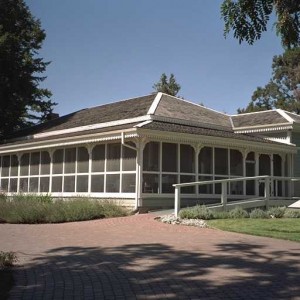Guisachan House
Place Description
The historic place is the single-storey Guisachan House, built in 1891 with wood siding in the Late Victorian manner and situated at 1060 Cameron Avenue in Kelowna's South Pandosy neighbourhood. The historic place includes the house and its two-acre lot with landscaping and gardens.
Heritage Value
The Guisachan House has heritage value for its vice-regal connection, because it was built and owned by Lord Aberdeen, Governor-General of Canada from 1893 to 1898. It also has value for its associations with local agriculture through its later owners. Furthermore, it has significance as a rare colonial bungalow, and as an early conservation project that demonstrates the value that the Kelowna community has placed on heritage conservation.
The Guisachan House is valued for its association with Lord and Lady Aberdeen. In 1890, a few years before he became Governor-General, Lord Aberdeen purchased the prosperous 480-acre ranch owned by John McDougall. The intention was to establish Lady Aberdeen's brother, Coutts Marjoribanks, who had been ranching with indifferent success in North Dakota, and who was now sent to manage this Kelowna property.
The Aberdeens visited their new property in 1891, and construction began on the house. Lady Aberdeen named it 'Guisachan' ('Place of the Fir' in Gaelic) after her childhood home in the Scottish Highlands. They planted rows of Scottish fir seedlings (later replaced with hardier native arborvitae) beside the driveway. The new farmhouse was a 'Colonial Bungalow,' whose design was derived from an East Indian house-type. The unusual house was built by David Lloyd-Jones, later the owner of a local sawmill. The house is valued today for its rare architectural style, with wood siding, elaborate moulding and trim under eaves and around windows.
The Aberdeens subsequently ordered additional development of the property, including planting 200 acres of orchard, and interested themselves in local community development. However the Aberdeens' interest in Guisachan waned after they bought another Okanagan estate, the Coldstream Ranch near Vernon, in 1892. Lord Aberdeen was appointed Governor-General of Canada in 1893, and until the end of his term in 1898 he could only visit the Okanagan for summer holidays.
The Guisachan House is also a reminder of the importance of agriculture in the development of Kelowna. The ranch was sold around 1900 to John Conlin, a former sea captain. Conlin sold it in turn in 1903 to W.C. Cameron, who had been manager of the 20,000-acre Edgeley Farm at Qu'Appelle, Northwest Territories (now Saskatchewan). Cameron concentrated on growing fruit and hay, and was president of the Kelowna Farmers' Exchange at the time of his death in 1910. Cameron's sons, W. Alister and Gilbert Douglas ('Paddy'), then jointly operated the ranch, growing mixed crops and livestock. Shortly after 1923 they split the acreage and livestock, Paddy Cameron taking the portion with this house on it. He shifted into dairy cattle, and from the 1930s until the late 1940s operated a retail dairy store in town. He then went into beef cattle until his retirement in 1965, when he sold the land but kept a life-lease on the house and seven acres.
Guisachan House is further valued as an example of community efforts in heritage conservation. Paddy Cameron was involved in local heritage efforts. He was president of the Okanagan Historical Society and was co-chair of the Pandosy Mission Committee from 1969 to 1972. He continued to reside in the Guisachan House until shortly before his death in 1984. After his death the Okanagan Historical Society adapted the house and reduced property for public use. The house and 2.4 acres of the original land are now Guisachan Park, which was opened on May 19, 1990, by the grandson of Aberdeens, Alastair Gordon, Sixth Marquess of Aberdeen, and his Marchioness, Anne Gordon. The house, with a wrap-around veranda added, now operates as Guisachan House Restaurant. This was an early and high-profile preservation project in Kelowna, and was important for raising awareness of the re-use potential of historic buildings.
Character Defining Elements
The character-defining elements of the Guisachan House include:
- Location in Guisachan Park
- Landscaping and gardens
- Row of native arborvitae trees beside the driveway
- Remaining orchard trees
- Farmhouse architecture in Colonial Bungalow style, including wood siding, elaborate moulding and trim under eaves and around windows
- Wrap-around veranda
- Extensive restoration work completed in 2009 following a significant fire







